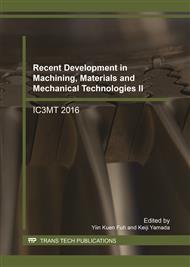[1]
K. Iwatsuka, Y. Maeda, H. Tanaka, T. Yazawa, and S. Suzuki, Effect of Tool Run-Out on Micro-Groove Milling for a Micro-channel Die International Journal of Automation Technology, Vol. 8, No. 2, 2014, p.275–281.
DOI: 10.20965/ijat.2014.p0275
Google Scholar
[2]
N. T. Nguyen and S. T. Wereley, Fundamentals and Applications of Microfluidics, Artech House, 2nd edition (Book).
Google Scholar
[3]
T. Kitamori, Microchip Analysis and Synthesis Systems, Trends in Academic, Vol. 14, No. 3, 2009, pp.42-45.
Google Scholar
[4]
M. Esashi, Micromachine /MEMS, Journal of the Japan Society for Precision Engineering, Vol. 75, No1, 2009, pp.78-79 (in Japanese).
DOI: 10.2493/jjspe.75.78
Google Scholar
[5]
A. Manz, J.C. Fettinger, E. Verpoorte, H. Ludi, H.M. Widmer and D.J. Harrison Micromachining of monocrystalline silicon and glass for chemical analysis systems A look into next century's technology or just a fashionable craze?, TrAC Trends in Analytical Chemistry, Vol. 10, 1991, pp.144-149.
DOI: 10.1016/0165-9936(91)85116-9
Google Scholar
[6]
M. Tokeshi, Glass chip manufacturing method using a semiconductor microfabrication technology, Electronic materials, 2005, pp.26-28 (in Japanese).
Google Scholar
[7]
J. H. Parka, N. -E. Leea,J. SParkb, and H. D. PArkb, Deep dry etching of borosilicate glass using SF 6/Ar inductively coupled plasma, Microelectronic Engineering, Vol. 82, 2005, pp.119-128.
DOI: 10.1016/j.mee.2005.07.006
Google Scholar
[8]
K. Iwatsuka, Y. Maeda, H. Tanaka, T. Yazawa, and S. Suzuki, Study on micro-groove milling of a micro-channel die—Selection guidelines for cutting conditions with micro end mills—, Proceedings of the 6th International Conference on Leading Edge Manufacturing in 21st century (LEM21), 2011, p.32.
DOI: 10.1299/jsmelem.2011.6._3273-1_
Google Scholar
[9]
Y. Maeda, K. Iwatsuka, Y. Isokawa, T. Yazawa, Y. Fukuda and S. Suzuki, Study on fine-groove milling of micro-channel die—Surface roughness and form accuracy of fine groove—, The 8th Manufacturing & Machine too Conference, 2010, p.249.
DOI: 10.1299/jsmemmt.2010.8.249
Google Scholar
[10]
H. Ogawa, M. Masuda, A. Akira, Y. Kogami, Effect of Cavitation of Cutting Fluid in Micro Drilling (1st Report), Journal of the Japan Society for Precision Engineering, 2006, p.626–630 (in Japanese).
DOI: 10.2493/jspe.72.626
Google Scholar
[11]
H. Ogawa, M. Masuda, A. Akira, Y. Kogami, Relation between Drilling Conditions and Tool Life in Micro Drilling (2nd Report), Journal of the Japan Society for Precision Engineering, 2007, p.578–582 (in Japanese).
DOI: 10.2493/jjspe.73.578
Google Scholar
[12]
G. Bissacco, H. N. Hansen, J. Slunsky, Modelling the cutting edge radius size effect for force prediction in micro milling, CIRP – Manufacturing Technology, Vol. 57, 2008, pp.113-116.
DOI: 10.1016/j.cirp.2008.03.085
Google Scholar
[13]
C. Y. Huang, J. J. Junz Wang, Mechanistic Modeling of Process Damping in Peripheral Milling, Transactions of the ASEM, Vol. 129, 2007, pp.12-19.
Google Scholar
[14]
Jean Philippe Costes, Vincent Moreau, Surface roughness prediction in milling based on tool displacements, Journal of Manufacturing Processes, Vol. 13, 2011, pp.133-140.
DOI: 10.1016/j.jmapro.2011.02.003
Google Scholar
[15]
Boxiao Ma, Mituyoshi Nomura, Takahiro Kawashima, Osamu Horiuchi, Study on Micro Drilling –Rotating Bending Fatigue of Micro Cardide Drills-, Engineering Materials, Vol. 407, 2008, pp.45-48.
DOI: 10.4028/www.scientific.net/kem.407-408.45
Google Scholar


